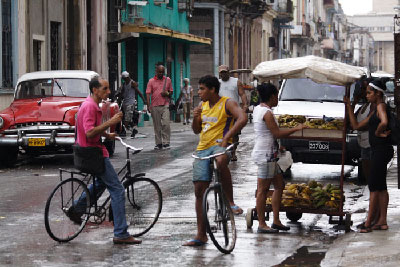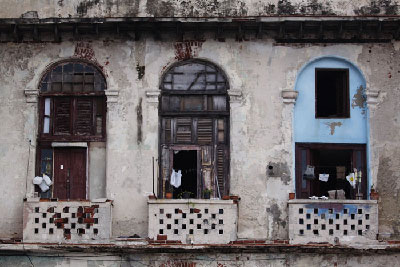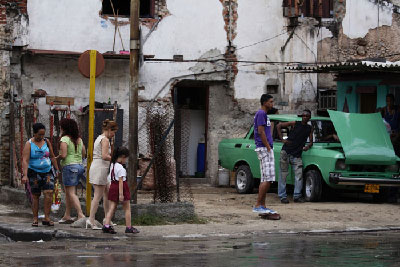Cuba’s Burning Economic Contradictions
by Pedro Campos

HAVANA TIMES – The now chronic disaster in the Cuban economy has led the leadership to try out a series of measures known as “la actualización” (updating), aimed at reducing State subsidies, raising taxes, lowering real wages, eliminating excess personnel on the State payroll and creating a more efficient bureaucratic structure, while at the same time strengthening the role of national and foreign capitalism. All of this without making any substantive changes in the political system.
It’s an eclectic mix that proposes the continuation of economic domination by the State, flirts with national and foreign capital and merely flashes a smile at the cooperative system without offering any real openings for developing independent worker-controlled forms of production.
“Free the productive forces!” cry the spokespeople for the new measures. But – who is responsible for keeping these forces boxed up and tied down? None other than the very same little group identified as the historic national leadership that decides everything. Grab the thief!
According to declarations of the national economic “managers” themselves, at this stage of the game, the “updating” decrees are not yielding the expected results.
In truth, the issue is clear: once we accept that the so-called “State socialism” model has failed, the only thing left for the Cuban economy is to advance decidedly towards privatization, as in China and Russia; or towards the socialization of property and full appropriation of the economy by the people – true socialism as demanded by the democratic socialists.
But the evolution in either direction is being blocked by the central bureaucratic apparatus, determined to maintain absolute control over the country’s economic and political system. As a result, the “updating” is neither consistent with the needs of private capitalism, nor with a true socialist economy in which freely associated forms of production predominate.
A move towards capitalism? Historic obstacles block the path
A number of countries in Europe and Asia formerly considered socialist ended by reestablishing private capitalism, with States and governments that range from democratic to authoritarian. The classic cases of Russia and China speak for themselves.
There, national and international private capital were allowed to take over the economies little by little until they predominated, although some branches of the economy remained in the hands of the state, with the goal of guaranteeing the optimal functioning of those private capitals.
But here in Cuba, the chosen “pragmatic” road of warming up to capitalism – the true meaning of the “updating” measures – comes up against not only the old neo-Stalinist bureaucracy, which wants to continue being called “socialist”, but also against another difficulty no less important: the source of that private capital couldn’t conceivably be anything other than the big neighbor to the North and the Cuban community that has settled there.
And that’s where the great contradiction of the new Platt* era arises: it’s clear that the current Cuban leaders are betting on the North’s help to pull out of the current hole, thinking that they’ll be able to count on the income from more than a million US visitors to the Cuban tourist areas each year and from the eventual large volume of trade around the Mariel Port mega-project. But it’s impossible for these plans to succeed unless the US blockade is lifted.

In China and Vietnam, foreign investment, particularly from the US and from residents living overseas, was successfully recruited without a previous process of political democratization. It seems to me that this was because there was not the level of animosity that persists between Cuba and the US, and the Chinese and Vietnamese communities living in the United States never attained the political influence of the Cuban community.
Further, the traditional economic, social and cultural ties between the United States and those countries never had the historic significance of the relations between Cuba and the US, marked by special ties for centuries.
Some analysts of relations between the US and Cuba believe that the Mariel project could offer such important economic benefits to the US that it could in itself represent an important impetus towards lifting the embargo-blockade.
Nonetheless, though it may present many economic benefits, it seems improbable that any US administration would decide to do so before substantial democratic changes had taken place in Cuba, due to the high political costs that a move to lift the blockade would imply internally and the oft-maintained US rejection of the current Cuban political leadership.
So, the Chinese road towards the dominance of private national and foreign capital doesn’t appear viable in Cuba unless the imperialist blockade were lifted; and this doesn’t seem like it could become a reality until a process of democratization were to take place in the current political system in Cuba, and the principal historic leaders were to really leave power.
In synthesis, these two capitalist forces – imperialism and the traditional Cuban wealthy class – openly confront the ruling bureaucratic bourgeoisie who nonetheless is relying on them to make their modernization effective. However, the contradictions between the two seem irreconcilable.
Since the Cuban government wants to continue being called “socialist” and their party to continue being called “communist” so that the international left will continue to offer them every type of consideration, they can’t openly adopt any measures that would allow them to lure private capitalism, such as a full opening to foreign investment and to the Cuban community outside the country, or a complete liberation of the marketplace from the state monopoly policies. That is one of the most flagrant contradictions of the updating plan.
Towards democratic socialism? A smile…and nothing more
As far as the true socialist path that the socialist and democratic left demand, it has by now been clearly demonstrated that the historic leadership, lord and master of the Cuban state, has no interest in taking that road.
The agricultural cooperatives that have proven their effectiveness continue functioning with many regulations and state limitations; the presence of cooperatives in other areas is left to the mercy of trial runs “with no hurry” carried out under state control.
There is no ample cooperative law that would make it possible for workers to form a free and voluntary productive union, much less are there state stimuli available for this. Regarding worker self-management within the state enterprises…silence. In brief, concrete measures to strengthen the socialist area of the economy are completely lacking.
Can imperialism be blamed for the fact that the government has been historically incapable of eliminating the absurd state controls, passing a broad cooperative law, supporting free associations for workers, allowing self-employment to function openly and without deviations, designing a tax structure that stimulates production instead of holding it back, facilitating the entry of resources that could help stimulate the popular economy? In short, there has been no effort to democratize the economy and move away from the bureaucratic state salary system.

Of course it’s not prepared to advance towards a true socialization of the economy because that would imply giving real power to the workers to the detriment of the bureaucracy.
It is difficult and painful to say this, but that same leadership which at one time was the hope of the Cuban people has today become the worst obstacle in the way of a socialist advance in Cuba.
A new kind of class confrontation
The new social composition of classes that the “updating” process is creating presents at one extreme the “unanticipated” bureaucratic political and military class that believes itself to be the legitimate owner of the country’s entire economy. At the other extreme is the dispossessed and badly paid class of salaried workers that the state exploits.
The new small and medium capitalists who exploit their own salaried workers represent a kind of nouveau riche class, benefitted by the updating measures but still held down by the State’s strictures. The salaried workers exploited by these newly wealthy live better than the State salaried workers and as such prefer private capitalism.
Then there are the true self-employed workers who don’t exploit outside labor – from the intellectuals and artists with large incomes right down to the elderly peanut sellers – all of them burdened by abusive state taxes. The state throws the new capitalists and their salaried workers into the same sack as the authentic self-employed, all under the label of “cuentapropistas” [self-employed].
And finally there are the cooperative members, formally organized or not, who work together and divide the profits; they are also smothered by state regulations.
Apart from all these, there is a class that’s not present in Cuba but which continues to push its agenda: the true wealthy capitalist class with large businesses, settled fundamentally in Miami. This class, exiled from power, has always aspired to return and today continues to plot its comeback on the heels of large international capital.
The bureaucratic bourgeoisie now finds itself confronting all of these other classes and national groupings because it lives off of them exploiting all of them directly through salaried work or via abusive taxes and monopoly control of the economy, trade, finances and the dual monetary system. They are the class that is impeding the development of all the others, be it the wealthy classes or the germinating socialist class.
Only themselves to blame
There’s no doubt about it: the productive forces in Cuba, be it for the development of private capitalism or to socialize the economy, are facing a common obstacle: the centralized state system and its bureaucracy determined to maintain itself in power indefinitely.
I don’t intend to sharpen contradictions that require peaceful and democratic solutions, but objectively the tendency of the class composition of Cuban society and an analysis of its interests presents the bureaucratic bourgeoisie created by State socialism as a kind of class that stands in opposition to social and economic advance in Cuba in any direction other than its own strengthening as a hegemonic group. In this way, they have positioned themselves against the entire Cuban people, against all of their classes and current social groupings.
According to Carlos Marx, when the productive forces are held back by the relations of production – in this case the salaried State workers – revolutions appear. Later, let them not blame the imperialists, the “counterrevolutionary” forces, the Miami “mafia”, the new technologies, nor much less the peaceful democratic and socialist left who have done everything possible to help find the road that they have blocked. Instead they should seek the causes from within, in their own self-interest, limitations and befuddlement.
—–
Pedro Campos: [email protected]
* The Platt Amendment was a 1901 treaty between the US and Cuba to “protect” Cuba from foreign intervention. It permitted extensive US involvement in Cuban international and domestic affairs.






It is what results from what you say: the state capitalist controls access to resources and – as Griffin correctly points out – uses that control to hold power over the people.
Cuba is a Stalinist inspired system where the totalitarian system grabs a hold of control over all aspects of life to ensure obedience and repress dissent.
Griffin just points out the logical consequence of your statement.
State capitalism is the best way to ensure resources are badly allocated. Cuba is a good example: 67-70% of the land to state farms (form of state capitalism) that were 25% as efficient as independent farmers. Result: the need to import 80% of the food the people consume.
An historical example: the take over of the Cuban rice farms by state capitalism :
“After WW2 imported rice was difficult to obrtain and costly, so Cuban farmers had an incentive to grow rice. In 1949 Cuba produced 10 percent of domestic consumption. In 1960, the year after Castro came to power, the Cuban rice harvest was 400,000 metric toms, making Cuba for the first time self-sufficient in rice. During the decade of the fifties, Cuban producers had successfully adopted the latest methods of rice farming employed in Louisiana and Texas. From the point of technological expertise, rice production outstripped that of any other branch of Cuban agriculture; and in terms of money value, rice became one of Cuba’s major crops. By 1962, with Cuban agriculture socialized, the rice yield was reduced by 50%. The same year, as has already been noted, the rationing of foodstuffs was introduced, with the rice ration set at 6 pounds per person per month.
…. That lowered per capita consumption by two thirds… More over, for low-income Cubans, for whom rice formed a more substantial part of their diet, the reduction was even greater.”
M. Halperin, Return to Havana, Vanderbilt University Press, Nashville, 1994, p.49-50.
The best standard of living for all is achieved in mixed systems where the resources come from the total wealth generated by the efforts of all and are distributed between capital and workers with taxes as a social correction to pay for adequate social services and to provide for those unable to sustain themselves.
State capitalism isn’t even communism (except for those of the Stalinist persuasion maybe even though they still claim it is the “workers” that control the assets and that the state paternalistically steps in for their “good”).
Not what I meant at all.
I think what you mean is,
“Totalitarian socialism holds power over the people by maintaining monopoly control of the economy.”
State capitalism is necessary. You have to get the resources you distribute to others from somewhere.
Best single analysis/educational I have read in a long time.
The biggest contradiction: a state capitalist system that claims to be socialist.
Cuba’s Stalinist System.
http://cubaverdad.net/stalinist_system.htm